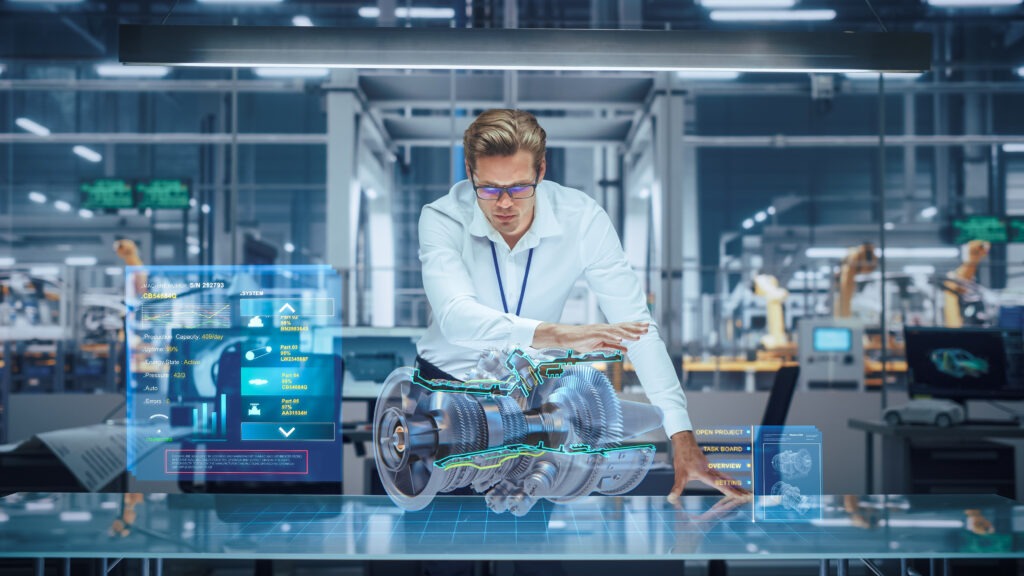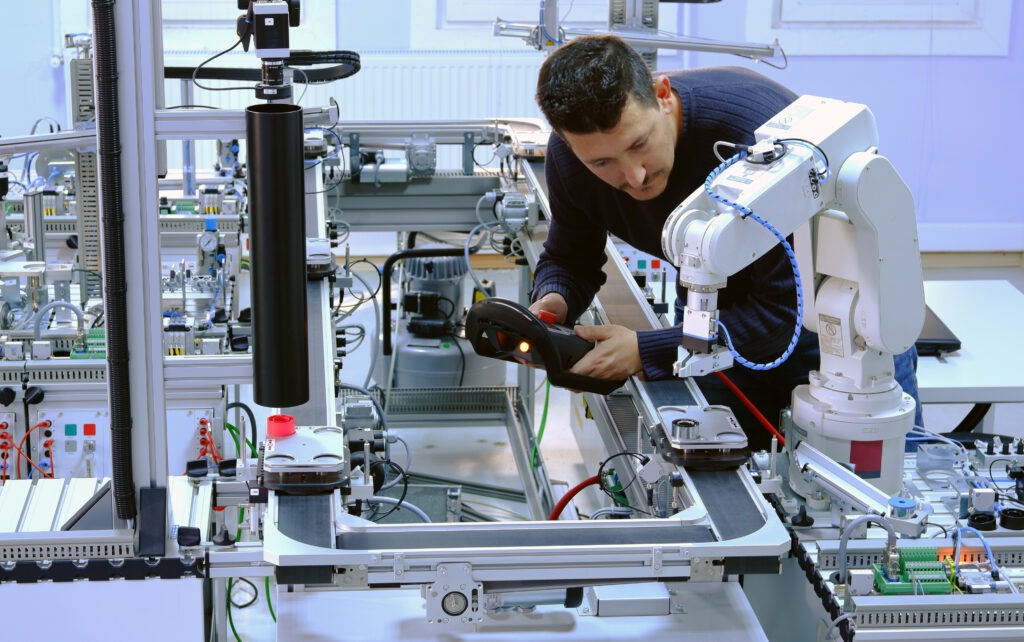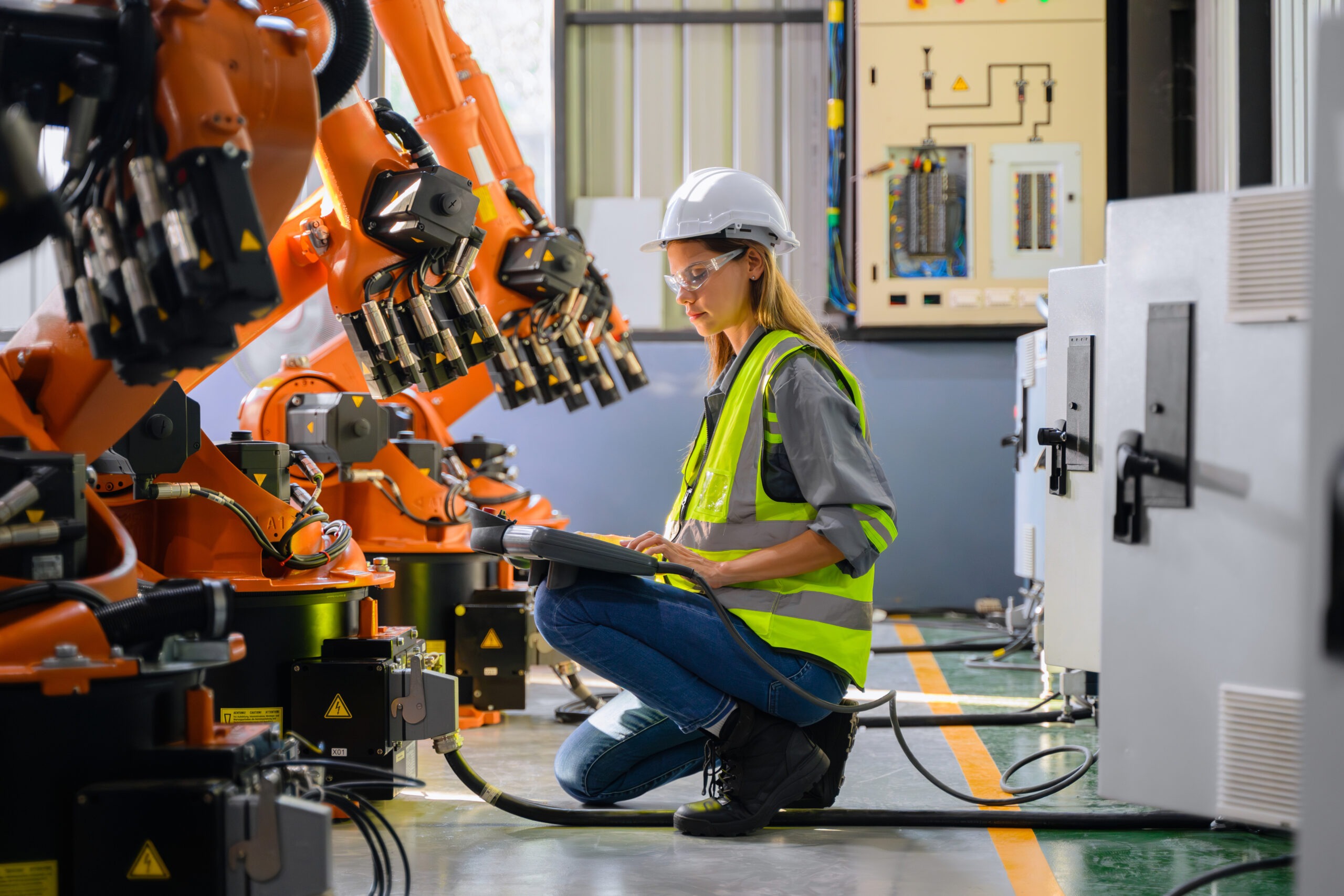Electricians in the industry sector
The industry sector offers a number of occupations for electricians that are similar to each other. Originally, the job title in this field was Industrial electrician. In addition, there were job profiles that now have more to do with electronics. These include the mechatronics technicians, electrical system fitters, microtechnologists and information system electronics technicians. You will find these electrical professions in the industry.
Table of contents
- Electricians in the industry sector
- The electronics technician for operating technology
- What does an electronics technician for automation technology do?
- What are the tasks of an electronics technician for devices and systems?
- What does an electronics technician for information and systems technology do?
- What are the tasks of an electronics technician for building and infrastructure systems?
- What do mechatronics engineers, microtechnologists, electrical system fitters, and IT systems electricians do?
Estimated reading time: 16 minutes
The electronics technician for operating technology
Electronics technicians for industrial engineering install electrical systems and components. This primarily involves the supply of electrical energy and the functionality of operating systems, building systems and automation technology.
What are the main tasks of an electronics technician?
Their tasks also include designing system modifications and planning system expansions. As a result, they install these modifications and extensions as well as cable routing systems and power lines. They also set up machines and drive systems. To do this, they install switchgear, test and programme the systems and ensure the functionality of the corresponding safety equipment.
During operation, they monitor and maintain the systems. This also includes regular inspections and troubleshooting. Electricians also coordinate the installation of systems by service providers and other trades, and oversee their work. Finally, electricians instruct the future operators on how to use the systems.
How does electronics technician training work, and what jobs can you do after?
The apprenticeship lasts three and a half years and is a recognised training occupation for electronics technicians in the industrial sector. Training in the skilled trades is also possible.
Increased digitalisation is opening up more and more professional fields:
- This begins with the 3D printing. This makes it possible to print or imprint electronic components. This allows complex systems to be equipped or supplemented with new parts in a relatively short time.
- This is joined by the 3D laser scanning. Damit werden die industriellen Betriebsanlagen und dazu auch deren Umgebung vermessen. Bevor Mitarbeitende Verlagerungs- oder Umbaumaßnahmen durchführen, prüfen sie, ob die Anlagen am neuen Standort ausreichend Platz haben – nicht nur für den Aufbau, sondern auch, um ihre Funktion zuverlässig auszuführen.
- In addition, the digitisation with 3D simulations neue Wege, Anlagen und Systeme zu entwerfen und zu planen. Ingenieurinnen und Ingenieure simulieren diese rechnergesteuert und testen sie anschließend in einem virtuellen Umfeld. Auf diese Weise erkennen und beheben sie Schwachstellen und potenzielle Fehler, noch bevor sie die Anlage herstellen.
- Elektroniker nutzen die 5G-Technologie, um digitale Netze aufzubauen – zum Beispiel für Automatisierungssysteme. Das macht es möglich, mit einem Computer mehr Maschinen zu kontrollieren, mögliche Fehler und Störungen noch vor deren Auftreten zu entdecken und zu beseitigen und insgesamt die Produktivität pro Angestelltem zu erhöhen.
Furthermore, Intelligent actuators can and will be installed. These are used in control and safety systems and offer various functions, including the ability to diagnose potential future faults.
What new fields are emerging in electronics through digitalisation?
- One particularly interesting new area is the augmented reality operation. This makes it possible to use virtually superimposed information. This allows test equipment, safety systems and production machines to be diagnosed and maintained
- Mitarbeitende nutzen zunehmend Apps, um die Prozesse in der Produktion zu überwachen. Mit diesen Anwendungen stellen sie die Betriebsbereitschaft der Systeme sicher und steuern die Fertigungssysteme gezielt.
- The digitalisation of connected buildings: Various systems are installed and networked in the buildings. These can then exchange information and make changes automatically.
- Robots in the industry are nothing new anymore. Nowadays, we are on the next level with cobots, the collaborative robots. These also need to be controlled and monitored. They have their own software that needs to be installed and monitored at work.
What tasks do electricians have in real-time data systems?
Echtzeitdatensysteme analysieren die Daten der Maschinen und sagen voraus, wann und wo Störungen auftreten können. Fachkräfte richten diese Systeme ein und verbessern sie kontinuierlich. Sie führen auch die Wartungsarbeiten aus, die diese Systeme anfordern. Auf diese Weise beheben sie Störungen, noch bevor sie tatsächlich auftreten. So vermeiden Unternehmen Arbeitsausfälle und reduzieren Wartezeiten auf ein Minimum. Bei guter Abstimmung erledigen die Techniker Reparaturen genau dann, wenn die Maschinen nicht gebraucht werden.
- With digitalisation, the original energy supply systems are now joined by the so-called smart grid. This allows electricity to be intelligently generated, stored and distributed according to current demand. Electricians install, maintain and repair the systems.
- This is complemented by smart metering. Intelligent measuring and metering devices are used. These record electricity consumption in real time and also remotely. These systems also need to be installed, maintained and, depending on the situation, repaired or expanded.
- In the course of digitalisation, one of the tasks of electricians is to create control and regulation programs for various automation systems using the programmable logic controller (PLC) . They also need to be maintained and faults rectified.
- The networked production systems are also a task for the electrician. These are production systems that operate in a network. Here, complete systems or their individual components must be installed, commissioned and kept in working order.
- Ultimately, digitalisation also involves virtual power plants. These are control systems that control decentralised energy generation plants. Here too, the systems and components must be installed, commissioned and maintained.
This has significantly expanded the field of work of an electronics technician for industrial engineering and offers many interesting new challenges. This is particularly interesting for the next generation, as it not only involves using a lot of technology, but also protecting the environment and keeping pace with the next industrial revolution.

What does an electronics technician for automation technology do?
Electronics technicians for automation technology have the task to analyse and understand the interrelationships between functions and processes within automated systems. This enables them to design and implement modifications and extensions. They also install drive systems, be they electric, pneumatic or hydraulic. In addition, they install equipment that takes measurements, controls and regulates other processes.
- As part of these systems, electricians configure or programme sensor systems. These are then adjusted and maintained as a result. The same tasks are also carried out for operating systems, bus systems and networks.
- Once installed, they combine the individual components into complex automation systems and create an integrated overall system. They also test the installations and instruct future users on how to use them. They then hand over the systems to these users.
- This is complemented by the fact that electricians can monitor and maintain and, if necessary, rectify faults. They use special test software and diagnostic systems to help them find and analyse the faults.
What new challenges does digitalisation bring for electronics technicians?
Digitalisation brings with it new challenges. These arise, for example, from the installation and integration of embedded systems. These are system software for automation systems. Also install the control systems and system software needed for industrial robots. These are then often enough networked with IoT platforms. The IoT is the Internet of Things and the use of blockchain technology.
- electricians also define the interfaces for communication between the various machines. In addition, there are systems with which production-related data is recorded and analysed. These must be installed and put into operation.
- Electronics engineers also work in the field of predictive maintenance. Automatic data acquisition is used to determine which faults may occur in the near future. These are then rectified as soon as possible by predictive maintenance before they can occur properly and lead to failures.
- In connection with this, electricians also take care of the sensor. In other words, they install the sensors that act as signalling devices for the automatic systems. These also have to be set up and maintained.
- The responsibilities of an electronics technician for automation technology have included digitalisation, service portals and service apps. Technikerinnen und Techniker verwenden diese Informationen für die technische Dokumentation der einzelnen Geräte. Außerdem stellen sie die Automatisierungstechnik den bestellenden Kunden zur Verfügung. Zudem ermöglichen sie dem Kunden, bei Störungen direkt Kontakt mit dem Elektriker aufzunehmen.
With the advent of new assistance technologies, electricians now have to install, set up and keep voice control systems operational. In addition, there are networked production facilities for which the corresponding network must be set up and expanded. Finally, more and more wearable technologies are coming onto the market. These include data glasses, for example, which help to monitor the operating status of the systems. These too must now be mastered, set up and used by the electrician.

What are the tasks of an electronics technician for devices and systems?
1. Customisation and production of electronic components
Device and system electronics technicians are responsible for customising assemblies for systems and devices, creating circuit boards and installing various components. They also manufacture electronic devices and entire systems for the individual applications for which they are needed. They also set these up accordingly, which often involves installing programmes or entire operating systems and configuring them for actual use.
This is supplemented by the fact that these electronics engineers check existing components. They also create device documentation and layouts for existing systems. These can then be handed over to the actual users.
2. Support for technology and production
Industrial electricians for devices and systems are also responsible for procuring components and equipment. In this way, they support technicians and electrical engineers in the realisation of orders. They create the planning for production processes and set up the production machines according to this planning. They install testing machines and thus support quality assurance.
3. Verification and documentation
Documentation and records are created for the systems and production. They are also responsible for the maintenance and servicing of the components and systems.
4. Fault diagnosis and customer service
During repair work at the customer's premises, they find sources of error, analyse the faults and rectify them. Defective parts are repaired or replaced, and users receive instruction on how to use the machines and systems.
5. Home energy management
Digitalisation offers new challenges in the field of home energy management, among other things. To this end, they design devices and systems that allow energy requirements to be controlled and they install, maintain and repair such systems.
6. Optimisation of human-machine communication
Electronics technicians for devices and systems also play a key role in making human-machine communication easier. To this end, they design and produce user interfaces. They also create user dialogues that are generally understandable so that future users can handle the systems without further help. They are therefore also involved in setting up networked production systems. They provide the human-machine interface and install the safety and monitoring systems.

What does an electronics technician for information and systems technology do?
Electronics technicians for information and systems technology work in the field of automation, information technology and communication systems. This includes signalling and safety systems, functional systems and control elements.
1. Planning, installation and expansion of systems
Electronics technicians for information and systems technology develop the plans for the systems and implement these plans by installing the entire systems or their components. They also set up the systems and install additional hardware or electronic components that expand the existing systems.
2. Set-up and configuration of IT systems
In addition, the information technology devices involved are installed. This includes configuring the operating systems. They also set up the necessary networks and set up the user interface and dialogues for the users.
3. Software customisation and programming
If standardised software solutions are available, they adapt them to the specific situation. They also programme the software components and set up the various interfaces. They test the systems and provide assistance in the event of system malfunctions. In such cases, for example, they adapt the software or replace defective hardware.
4. Digitalisation and driver assistance systems
With digitalisation, the work of electronics technicians for information and systems technology also extends to the development, installation and control of driver assistance systems. This includes the development of human-machine interfaces. Above all, these must be programmed in a user-friendly way.
5. Work in the field of sensor technology and networked production
They also work in the field of sensor technology. This records process variables and what is happening in production in order to provide signals for the individual system components and their work. They are also involved in networked production systems. To this end, they install components that network the automation systems and make them user-friendly.

What are the tasks of an electronics technician for building and infrastructure systems?
An electronics technician for building and infrastructure systems can be deployed in a variety of ways. They work in residential and industrial facilities, schools and hospitals.
1. Installation and networking of building systems
Here, he sets up the various systems for security, heating, ventilation and energy supply. He installs the relevant devices and components and networks them into a whole that functions smoothly and automatically.
1. Integration, configuration and handover of building systems
The building's systems and control equipment are integrated and configured for this purpose. The new users are familiarised with the handling and the systems are then handed over to them.
2. Monitoring, maintenance and customer advice
Electronics technicians for building and infrastructure systems use control systems to monitor the operation of the systems. They check the installation of the components and ensure that the applicable safety regulations are complied with. They also carry out diagnostics to find faults and repair or maintain technical equipment. They advise customers on the selection of systems, the planning of the overall system and the calculation of costs. They award contracts to subcontractors and accept the services of third parties.
3. Digitalisation and 5G in the building infrastructure
With digitalisation, electronics engineers for building and infrastructure systems are also increasingly using 5G technology. This means that building infrastructures are networked with its help, which enables an accelerated digital exchange of data.
4. Ambient assisted living (AAL)
They also work in the field of AAL, or ambient assisted living. Here, they install smart home systems that make everyday life easier for older people and those in need of care.
5. Use of augmented reality
Digitalisation is also bringing greater integration of augmented reality for electronics technicians for building and infrastructure systems. This means that virtually superimposed information can be used to maintain or repair air conditioning and heating systems.
6. Connected buildings & connected living
Electronics technicians for building and infrastructure systems are also involved in the field of connected buildings. This means that they install communication technology and building systems and network these with automation systems.
They are also active in connected living. Here, electronics technicians for building and infrastructure systems install and set up the operating systems. These control the entire home, from the lighting to the air conditioning and heating systems. These are connected to a smartphone and can thus be controlled with a few tabs.
7. Smart hospitality
This is complemented by work in the Smart Hospitality. Sensors are installed for this purpose. These help hotels to track customer behaviour and identify which services are needed and when.
8. Setting up voice assistants
This reaches its peak with the installation of voice assistants. These allow devices in the smart home, smart hospitality or connected building to be controlled using voice commands. This makes them much easier to use.
9. Use of drones for inspection
Even drones are not foreign to an electronics technician for building and infrastructure systems. Although he does not set them up, he does use them. They can be used to inspect solar installations and, if necessary, wind turbines, enabling them to find faults and rectify malfunctions.
Of course, training to become an electronics technician for devices and systems is as varied as the tasks involved. This is what makes it particularly interesting and challenging at the same time - it is guaranteed never to be boring.
What do mechatronics engineers, microtechnologists, electrical system fitters, and IT systems electricians do?
In an increasingly digitalised world, specialised professionals play a crucial role in the development, maintenance and optimisation of modern systems and facilities. Professions such as mechatronics engineer, microtechnologist, electrical system fitter and IT systems electricians are exemplary of this development. They combine mechanical expertise with electrical, electronic and digital skills. Each of these professions offers exciting fields of work, innovative technologies and excellent future prospects. In the following article, we provide an overview of the tasks, training and career opportunities of these versatile professions.
Related topics:




